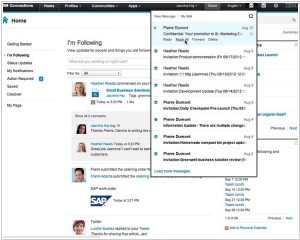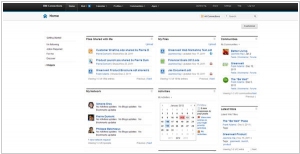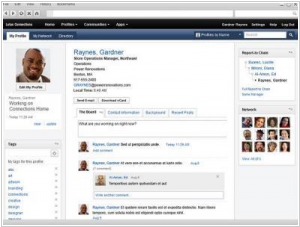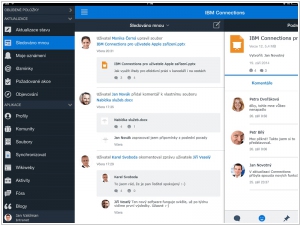HCL Connections is #8 in Top 10 Enterprise Social Software
HCL Connections (formerly IBM Connections) is social software for business that lets you access everyone in your professional network, including your colleagues, customers, and partners.
Positions in ratings
#8 in Top 10 Enterprise Social Software
Alternatives
The best alternatives to HCL Connections are: SharePoint, Microsoft Teams, Confluence, Slack, Yammer, Jive
Latest news about HCL Connections
2013. IBM kills Lotus. Microsoft kills SharePoint

Perhaps the two most famous brands in the history of enterprise software, Lotus and SharePoint, will soon disappear. We mean brands, not specific products. Because by renaming their products, vendors try to erase the association with outdated technologies in customer brain. For example, Lotus appeared back in the 80-s years of last century. In 1995 IBM acquired Lotus Development and began selling their products Lotus Notes/Domino. In the following years most IBM collaboration systems moved under the Lotus umbrella. But last year the revolution occurred. The last child of the Lotus family - SaaS suite LotusLive was renamed to SmartCloud for Social Business. And then the name Lotus was removed from other products. The final nail was the recent launch of Notes/Domino 9.0 Social Edition (without Lotus). ***
2013. IBM embed Email into Connections to drive users out of Email

For quite some time, collaboration vendors have been attempting to steer users away from relying on email. They aim to convince us that sharing files and information through alternative means is more convenient than traditional email communication. However, users are reluctant to abandon a technology that has proven its effectiveness over many years, with the inbox remaining the primary workspace for most information workers. Nevertheless, IBM has devised a novel approach to encourage people to transition from email to social tools by integrating email functionality into their social intranet, IBM Connections. Now, users can access emails, contacts, and calendars (stored in either Lotus Domino or Microsoft Exchange mail servers) directly within the Connections interface. This integration offers users the flexibility to choose between sharing content or sending an email, all without needing to switch between applications. Furthermore, if a user opts to "send an email," they can select files from the IBM Connections Files storage. In such cases, the system doesn't attach files to the email; instead, it inserts links to the message and automatically shares the files with the recipients. Clearly, IBM's intention is to position Connections as the central hub within its collaboration suite, much like Microsoft's SharePoint in their suite. In fact, IBM's suite is aptly named IBM SmartCloud for Social Business, emphasizing the importance of the "social" aspect in their comprehensive offering.
2012. IBM LotusLive becomes SmartCloud for Social Business

IBM's SaaS collaboration services under the LotusLive umbrella received a lot of good reviews and always presented in the analyst top product lists. Nevertheless they haven't been very successful in sales (compared to the competitors). "What's the problem?" - IBMers tried to figure out - "Maybe the problem in the name? Or in marketing?". And they decided to copy the model of Salesforce and to see what will happen. They decided to remove the word "Lotus", which many people associate with the heavy software from the past. And instead, wherever it's possible, they put the words "Cloud" and especially "Social". In result, LotusLive becomes SmartCloud for Social Business. In its description you'll find such words as Social, Social and Social. And on the US television the new SmartCloud cartoon commercial (reminding Salesforce Chatter ads) has appeared (watch the video). ***
2010. Lotus Connections 3.0 gets social recommendations

Enterprise social software developers continue to copy Facebook features. The new version of IBM's enterprise social networking software Lotus Connections 3.0 features widgets with social recommendations. First is a list of "recommended friends," that user sees when logging into Lotus Connections. The fact is that Lotus Connections also includes "friends" feature - social connections. You become a "friend" when subscribe to collegue updates (microblog). So now, basing on your existing friends, your interests and expertise and your previous actions - the system provides a list of users that you are interested in "making friends" with. Besides, when visiting other user profiles, you now can see the social path that links you to this person and things that you have in common (such as a list of the communities that both belong to). And on the communities page you can see the widget with a list communities that you might be interested in. ***
2009. IBM unveils LotusLive Connections
IBM has introduced LotusLive Connections, a software-as-a-service (SAAS) version of its Lotus Connections social networking suite. Initially launched in 2007 as a collaboration suite for businesses aiming to benefit from the popularity of platforms like Facebook, Lotus Connections offers various applications such as employee profiles, blogging, bookmarks, and community features. Building upon the success of LotusLive Engage, IBM's first SAAS social networking and collaboration application released in April, LotusLive Connections represents a departure from the traditional approach of using hosted software. Right from the start, users of LotusLive Connections can take advantage of the Connections Activities app, which facilitates file sharing and instant messaging conversations.
2009. IBM has announced the commercial availability of LotusLive Engage
IBM has unveiled LotusLive Engage, an integrated social networking and collaboration cloud service. Initially targeting small to mid-size businesses, the project incorporated valuable feedback from beta testers to refine the interface. The console layout is sleek and user-friendly, making it familiar to enterprise users who have experience with products like Notes or Microsoft Exchange. LotusLive Engage facilitates communication and collaboration both within and outside the corporate firewall, enabling employees to engage with clients, partners, and suppliers. IBM refers to this as "extranet collaboration." Key features include profile and contact management, online meetings, file sharing, instant messaging, and project management capabilities. All data stored on LotusLive services is hosted in an IBM-managed cloud. Pricing for the service will range from $10 to $45 per user.
2009. IBM Lotus Introduces New Portfolio of Integrated Cloud Services
IBM has introduced LotusLive, a cloud-based suite of social networking and collaboration services tailored for business use. LotusLive, available at LotusLive.com, combines various cloud solutions like email, collaboration, and web conferencing services. With over 20 years of collaboration experience, IBM aims to simplify and enhance business interactions with partners and customers through LotusLive. The platform emphasizes simplicity, ease of use, and accessibility, allowing companies of all sizes to connect and collaborate without the need for significant upfront IT investments. LotusLive is built on open web-based standards and offers integration with third-party applications. IBM also announced partnerships with Skype, LinkedIn, and salesforce.com to deliver integrated collaborative solutions to a global audience. LinkedIn will connect its professional network with LotusLive, allowing users to search and collaborate seamlessly. Salesforce.com showcased the integration of LotusLive services within its CRM solutions, while Skype plans to integrate its voice and video capabilities with LotusLive. These partnerships further expand the collaborative capabilities of LotusLive and provide enhanced communication experiences. To learn more about LotusLive, visit www.LotusLive.com.


